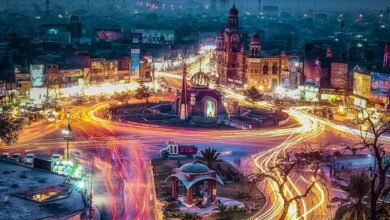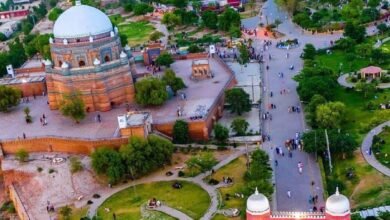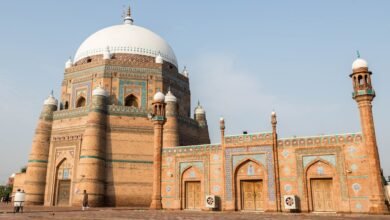
Multan’s Famous Mausoleums, Multan, often called the “City of Saints,” is renowned for its rich spiritual heritage and numerous mausoleums that dot its landscape. These grand structures serve as a testament to the city’s deep-rooted religious traditions and attract visitors from all walks of life. In this article, we will explore some of Multan’s most famous mausoleums, delving into their historical significance, architectural magnificence, and spiritual appeal.
Multan, located in the heart of Pakistan’s Punjab province, is a city steeped in history and culture. It holds a special place in the hearts of many due to its association with renowned Sufi saints and their mausoleums. These mausoleums serve as revered landmarks, embodying the spiritual essence of the city and drawing in countless pilgrims and tourists year after year.
Read More: Multan’s Literary Heritage: 6 Important City’s Literary Connections
Overview of Multan’s Mausoleums
Multan’s Famous Mausoleums, Multan boasts a vast array of mausoleums dedicated to various Sufi saints who played pivotal roles in spreading Islam and Sufism in the region. These mausoleums are not only architectural marvels but also symbols of religious devotion and cultural heritage. Each mausoleum tells a unique story, blending history, spirituality, and artistic excellence.
Historical Significance of Multan’s Mausoleums
Multan’s Famous Mausoleums, The mausoleums of Multan hold immense historical significance, as they stand as witnesses to the city’s rich past. Over the centuries, Multan has been a center of spiritual and cultural activity, attracting scholars, mystics, and pilgrims from far and wide. The mausoleums, with their timeless elegance, provide a tangible link to this vibrant history.

Tomb of Shah Rukn-e-Alam
Multan’s Famous Mausoleums, One of the most revered mausoleums in Multan is the Tomb of Shah Rukn-e-Alam. This splendid structure, dedicated to the famous Sufi saint Shah Rukn-e-Alam, showcases remarkable architectural prowess. Its circular dome, adorned with intricate blue and white tile work, stands as a testament to the Mughal era’s artistic brilliance.
Architecture and Design
The Tomb of Shah Rukn-e-Alam follows a quintessential Indo-Islamic architectural style, with influences from Persian and Central Asian designs. The elaborate entrance gate, known as the “Buland Darwaza,” welcomes visitors with its grandeur and intricate detailing. Inside, the tomb chamber features a mesmerizing octagonal shape, accentuated by delicate floral motifs.
Spiritual Significance
Shah Rukn-e-Alam holds a significant place in the hearts of Multan’s residents and devotees. His teachings of love, harmony, and tolerance continue to inspire generations. Visitors to the mausoleum seek solace, pray for blessings, and connect with the saint’s spiritual presence. The atmosphere is imbued with serenity and reverence, offering a sanctuary for spiritual seekers.
Visitor Experience
When visitors step into the Tomb of Shah Rukn-e-Alam, they are transported to a bygone era of grandeur and piety. The tranquil surroundings, adorned with lush gardens, provide an oasis of peace amidst the bustling city. Pilgrims and tourists alike can explore the intricate calligraphy, marvel at the stunning frescoes, and pay their respects to the revered saint.
Tomb of Shah Shams Tabriz
Multan’s Famous Mausoleums, Another notable mausoleum in Multan is the Tomb of Shah Shams Tabriz, dedicated to the famous Persian Sufi saint. Shah Shams Tabrizi’s teachings of divine love and spirituality have left an indelible mark on Multan’s cultural fabric.
Importance and Legacy
Multan’s Famous Mausoleums, Shah Shams Tabrizi’s teachings emphasized the unity of all beings and the importance of inner enlightenment. His words resonated deeply with the people of Multan, and his tomb became a site of pilgrimage for those seeking spiritual guidance. Even today, his legacy lives on, inspiring individuals on their spiritual journeys.

Architecture and Artistry
The Tomb of Shah Shams Tabriz features a blend of architectural elements from various eras. The tomb’s dome, adorned with blue and turquoise tiles, exudes a sense of tranquility. Intricate calligraphy and delicate stone carvings adorn the walls, showcasing the skilled craftsmanship of the artisans who created this masterpiece.
Pilgrimage and Devotion
Multan’s Famous Mausoleums, Pilgrims flock to the Tomb of Shah Shams Tabriz to seek blessings and connect with the saint’s mystical presence. The mausoleum’s atmosphere is permeated with devotion, as visitors recite prayers and offer tributes to the saint. The communal spirit of the pilgrimage fosters a sense of unity among the devotees.
Mausoleum of Bahauddin Zakariya
The Mausoleum of Bahauddin Zakariya pays homage to one of Multan’s most revered saints. Bahauddin Zakariya was a prominent Sufi saint and scholar who played a vital role in spreading Islam in the region.
Life and Contributions of Bahauddin Zakariya
Bahauddin Zakariya’s teachings centered on spirituality, knowledge, and selflessness. His deep understanding of Islamic philosophy attracted countless followers, and his mausoleum serves as a reminder of his enduring impact on Multan’s cultural and religious landscape.
Architectural Features
The mausoleum’s architecture blends influences from various architectural styles prevalent during the saint’s lifetime. Intricate brickwork, elegant arches, and ornate domes characterize the structure, symbolizing the fusion of spirituality and artistic expression.
Religious and Cultural Importance
Multan’s Famous Mausoleums, The Mausoleum of Bahauddin Zakariya is not only a site of religious significance but also a cultural hub. It serves as a meeting point for scholars, artists, and seekers of knowledge. The mausoleum’s courtyard often hosts events and gatherings, fostering a sense of community and intellectual exchange.

Tomb of Shah Yusuf Gardezi
Multan’s Famous Mausoleums, The Tomb of Shah Yusuf Gardezi is another prominent mausoleum in Multan, paying tribute to a revered Sufi saint and scholar.
Sufi Tradition and Teachings
Shah Yusuf Gardezi’s teachings emphasized the importance of selflessness, love, and humility. His spiritual insights continue to resonate with those seeking a deeper connection with the divine. The mausoleum stands as a beacon of spiritual guidance and a place of solace for those in search of inner peace.
Architectural Elements
Multan’s Famous Mausoleums, The tomb’s architectural elements reflect the artistic brilliance of the era in which it was constructed. The use of locally sourced red brick, intricate floral patterns, and geometric designs enhance the mausoleum’s visual appeal. The serene atmosphere and well-maintained gardens surrounding the tomb create an ambiance conducive to contemplation and reflection.
Religious Pilgrimage
Multan’s Famous Mausoleums, Devotees and pilgrims visit the Tomb of Shah Yusuf Gardezi to pay their respects and seek blessings. The mausoleum’s tranquil surroundings provide a respite from the outside world, allowing visitors to connect with the saint’s teachings and find spiritual solace. The pilgrimage experience fosters a sense of unity and shared devotion among the faithful.
Tomb of Shah Ali Akbar
The Tomb of Shah Ali Akbar commemorates the life and teachings of a revered Sufi saint who played a significant role in Multan’s spiritual history.
Mystical Teachings and Influence
Multan’s Famous Mausoleums, Shah Ali Akbar’s mystical teachings revolved around the attainment of spiritual enlightenment through devotion and self-discovery. His profound insights into the human soul and the nature of divine love continue to inspire spiritual seekers to this day.
Architectural Splendor
The tomb’s architectural splendor captivates visitors with its intricate stonework, mesmerizing frescoes, and beautifully crafted domes. The interplay of light and shadow, combined with the symphony of colors, creates a serene ambiance that elevates the spiritual experience.
Spiritual Significance
Multan’s Famous Mausoleums, The Tomb of Shah Ali Akbar serves as a place of pilgrimage, attracting devotees seeking spiritual guidance and blessings. The mausoleum’s serene atmosphere, coupled with the saint’s mystical presence, offers a sanctuary for contemplation and reflection.

Tomb of Shah Rukne Alam
The Tomb of Shah Rukne Alam is an architectural marvel that stands as a testament to the city’s rich history and cultural heritage.
Historical Background
Multan’s Famous Mausoleums, The mausoleum was built in the 14th century to honor the revered Sufi saint, Shah Rukne Alam. It is the largest and most magnificent mausoleum in Multan, serving as a significant landmark and a symbol of the city’s spiritual legacy.
Architectural Marvels
Multan’s Famous Mausoleums, The Tomb of Shah Rukne Alam showcases exquisite craftsmanship and architectural ingenuity. Its impressive dome, adorned with intricate tile work and geometric patterns, captures the essence of Mughal aesthetics. The mausoleum’s interior is adorned with intricate frescoes, calligraphy, and decorative motifs, offering a visual feast for visitors.
Cultural Heritage and Tourism
The mausoleum’s historical and architectural significance has made it a popular tourist attraction. Visitors from all over the world come to witness the grandeur of the structure and pay their respects to the saint. The tomb’s surroundings, including beautifully landscaped gardens and peaceful courtyards, provide an immersive experience that transports visitors to a bygone era.
Importance of Mausoleums in Multan’s Identity
Multan’s Famous Mausoleums, Multan’s mausoleums hold immense significance in shaping the city’s cultural identity. They serve as reminders of the region’s deep-rooted spiritual traditions and act as cultural touchstones that foster a sense of pride among the local community. The mausoleums contribute to Multan’s tourism industry, attracting visitors who seek a glimpse into the city’s rich history and architectural heritage.

Multan’s Famous Mausoleums, Conclusion
Multan’s famous mausoleums are not just architectural wonders but living testament to the city’s spiritual heritage. These sacred sites offer a glimpse into the region’s rich history, cultural traditions, and the teachings of revered Sufi saints. Visitors are captivated by the awe-inspiring architecture, the serenity of the surroundings, and the sense of spirituality that permeates these mausoleums. Exploring Multan’s mausoleums is a journey of self-discovery, enlightenment, and a unique opportunity to pay homage to the saints who have left an indelible mark on the city’s identity.
Read More: Multan’s Textile Industry: A Legacy of Fine Fabrics
FAQs
Can visitors enter the mausoleums?
Yes, visitors can enter the mausoleums and explore their architectural splendor and spiritual ambiance. However, it is important to maintain a respectful demeanor and follow any guidelines or restrictions set by the authorities.
Are there any restrictions or dress codes for visitors?
While there might not be strict dress codes, it is advisable to dress modestly out of respect for the religious and cultural significance of the mausoleums. Visitors are encouraged to dress in attire that covers their shoulders, chest, and legs.
Are guided tours available at the mausoleums?
Yes, guided tours are often available at the mausoleums, allowing visitors to learn about the historical and cultural significance of each site. These tours provide valuable insights into the architecture, spiritual traditions, and stories associated with the mausoleums.
Can I take photographs inside the mausoleums?
Photography policies may vary for each mausoleum. While photography is generally allowed in designated areas, it is important to be mindful of the sanctity of the space and to respect any signage or instructions provided by the authorities.
Is there an entrance fee to visit the mausoleums?
In some cases, there might be a nominal entrance fee to visit the mausoleums. This fee contributes to the maintenance and preservation of these historical sites. It is advisable to check the latest information or contact the local authorities or tour operators for accurate details regarding entrance fees.








2 Comments